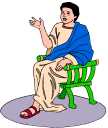The
Twelve Tables: Basis of Roman Law
In
the history of governments, the Twelve Tables occupy a
special place. At once, they are the basis of the Roman
Republic, the basis of Roman Law for centuries, and the germ
of the idea that evolved into humanism, the philosophy of
John Locke, and the Declaration of
Independence.
We're
talking about, of course, the protection of certain
rights.
 By
about the 6th century B.C., Roman people (who weren't
slaves) could be divided into two classes: patricians and
plebeians. The former were wealthy, landowning citizens who
had money and power and wealth and the right to vote. The
latter were none of the above (or very little) but were not
slaves. Since the patricians made up most of the ruling
class and made the laws, they tended to make laws to protect
their own interests. If the interests of the plebeians got
in the way, then the laws came first--at least that's what
the patricians thought.
By
about the 6th century B.C., Roman people (who weren't
slaves) could be divided into two classes: patricians and
plebeians. The former were wealthy, landowning citizens who
had money and power and wealth and the right to vote. The
latter were none of the above (or very little) but were not
slaves. Since the patricians made up most of the ruling
class and made the laws, they tended to make laws to protect
their own interests. If the interests of the plebeians got
in the way, then the laws came first--at least that's what
the patricians thought.
 The
plebeians had other ideas. They wanted certain basic rights,
and they were willing to cause civil disturbances to get it.
They even threatened to secede, in 494. By this time, the
sheer numbers of the plebeian class made the patricians sit
up in their governing chairs and take notice. The result was
the Twelve Tables.
The
plebeians had other ideas. They wanted certain basic rights,
and they were willing to cause civil disturbances to get it.
They even threatened to secede, in 494. By this time, the
sheer numbers of the plebeian class made the patricians sit
up in their governing chairs and take notice. The result was
the Twelve Tables.
The
Tables themselves, which were finalized in the mid-5th
century, were pieces of stone with writing carved into them.
The main benefit of having laws written down was that the
lawmakers and law-enforcers couldn't change them to suit
their whims. Once a law was made public (and carving it into
stone was about as public as it got), the law was known to
everyone. This also had the benefit for the lawmakers and
law-enforcers of ruling out a lawbreaker's protestation that
he or she didn't know that what he or she was doing was
against the law. If a law was made public, then it was
everyone's responsibility to know and obey.
 Specifically,
of the fragments of the Twelve Tables we have remaining,
here are some points of interest:
Specifically,
of the fragments of the Twelve Tables we have remaining,
here are some points of interest:
- Table I
mandates that when a person is accused of something, both
accused and accuser must be present at a hearing or trial
on the matter. Also, if both parties don't show up for a
court date, the judge is free to rule in favor of the
party that did show up.
- Table III gives
debtors 30 days to pay off a debt. After that, a creditor
is free to seize the debtor and make him or her a
prisoner.
- Table IV makes
a man's will binding.
- Table VIII
lists specific punishments for certain crimes. It also
says that if a person fails to show up as a trial
witness, then that person will never again be allowed to
be a witness. Most importantly, it says that a person
shown to have lied in court will be put to
death.
- Table IX
specifies capital punishment for judges who have taken
bribes and for people who have committed
treason.
It's
also interesting to note that Table XI prohibits marriages
between plebeians and patricians. So, even though the
plebeians got some very important rights through the Twelve
Tables, they couldn't marry into the upper class. The ruling
class had to keep the other hand, after all.



 By
about the 6th century B.C., Roman people (who weren't
slaves) could be divided into two classes:
By
about the 6th century B.C., Roman people (who weren't
slaves) could be divided into two classes:  The
plebeians had other ideas. They wanted certain basic rights,
and they were willing to cause civil disturbances to get it.
They even threatened to secede, in 494. By this time, the
sheer numbers of the plebeian class made the patricians sit
up in their governing chairs and take notice. The result was
the Twelve Tables.
The
plebeians had other ideas. They wanted certain basic rights,
and they were willing to cause civil disturbances to get it.
They even threatened to secede, in 494. By this time, the
sheer numbers of the plebeian class made the patricians sit
up in their governing chairs and take notice. The result was
the Twelve Tables.
 Specifically,
of the fragments of the Twelve Tables we have remaining,
here are some points of interest:
Specifically,
of the fragments of the Twelve Tables we have remaining,
here are some points of interest:

